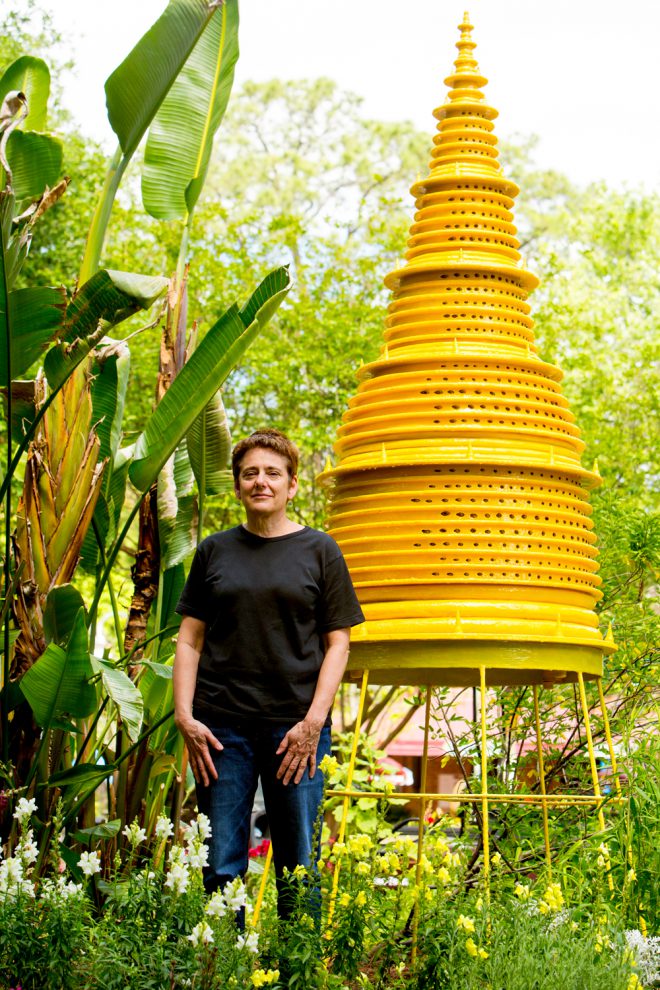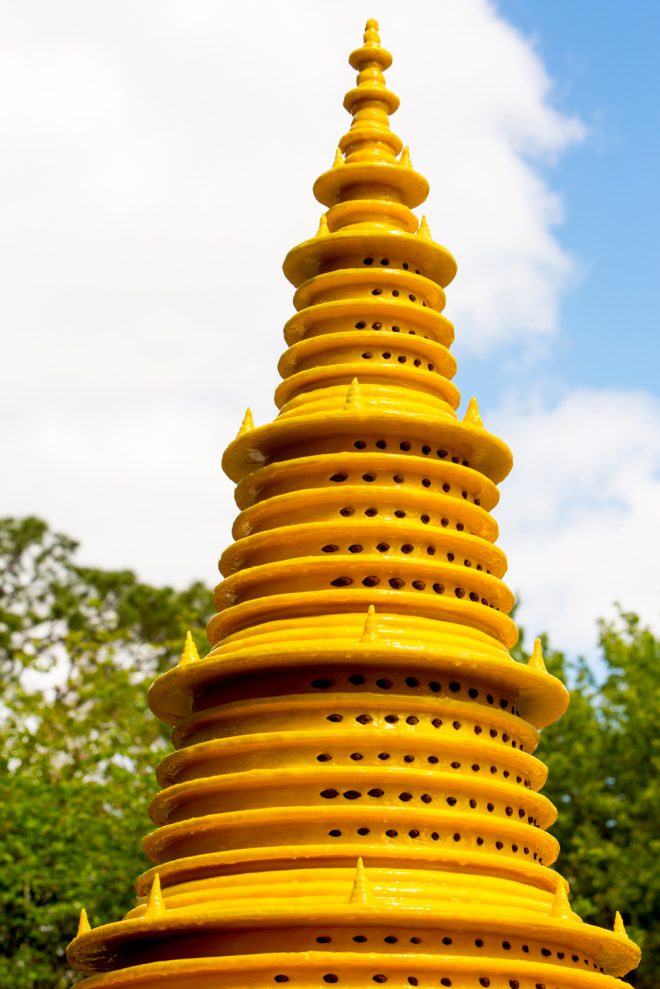The Plight of the Bees: Esther Solondz at the Audubon Zoo
Brooke Schueller heads to the zoo to visit artist Esther Solondz’s new sculpture, which gives bees a place to rest and reproduce.

Artist Esther Solondz with her Bee Palace, 2017, at the Audubon Zoo, New Orleans. Courtesy the artist and A Studio in the Woods, New Orleans. Photo by Sabree Hill.
I arrived at Esther Solondz’s Bee Palace, 2017, at golden hour and was peering at the towering, yellow hive through the afternoon’s slanting rays when a voice emerged from behind me.
“I’ve never seen one like that before,” the voice said. I turned around to find a boy. Like a character from a Faulkner novel, he spoke slowly, earnestly. He worked for the concessions stand but hoped to be a zookeeper one day, he said. He had worked with a beekeeper in Texas before coming to the Audubon Zoo, but he had never seen a hive like that before.
“I hear they’re planning on using the honey to feed to the bears,” he said. “But you can’t always believe what you hear.”
He was half-right, as it turns out. Though the zoo has two honeybee hives in their Louisiana Swamp exhibit, the Bee Palace is intended for solitary bees that do not live in colonies, produce honey, or have queens. Resembling a yellow, multi-tiered cake befitting Marie Antoinette, Solondz’s ornamental contribution to the plight of our imperiled pollinators blends functionality and art in a way that advances environmental justice. Produced in collaboration with entomologist Claudia Riegel of Tulane University and the New Orleans Mosquito Board as part of Solondz’s residency with A Studio in the Woods, the Bee Palace is, in essence, a refuge for transient bees where they can rest and reproduce. The palatial bee hotel is constructed of tubes where they lay their eggs, provide for their larvae, and then leave. Furthermore, the structure provides an educational opportunity through signage posted in the garden to teach students and others about the bees’ crucial role in our collective survival.
The Bee Palace is not Solondz’s first foray into environmentally inspired works. Not only has she worked with materials such as salt, water, soap, and rust in the past, she also installed a similar structure, the Hummingbird Palace, in Providence’s Lippitt Park in 2014. As with the Bee Palace, this sculpture was intended as an ornamental refuge for the whirring birds whose habitats have been threatened in recent years by man-made development.

Installation view of Esther Solondz’s Bee Palace, 2017, at the Audubon Zoo, New Orleans. Courtesy the artist and A Studio in the Woods, New Orleans. Photo by Sabree Hill.
Lest we forget, bees represent an essential link in our food chain in that they pollinate the plants that eventually become our foodstuffs. In 2016, the United States lost 44% of its honeybee colonies, a jarring statistic behind which stands a complicated matrix of causes. Beekeepers began to notice hives dying off in unprecedented numbers around 2008, in a phenomenon that came to be known as colony collapse disorder. The problem stems from any number of causes: environmental and climate changes, predatory varroa mites that feed on bees, and, most controversially, pesticides.
In 1985, the Bayer corporation introduced neonicotinoid pesticides, which gained in popularity in the late 1990s and early 2000s. These pesticides are systemic as opposed to superficial. Rather than spraying plants with pesticide, the seeds themselves are coated in the neonics, meaning the pesticide is internalized through the roots and distributed throughout the plant. Proof that neonics affect the central nervous system of bees, damaging their memory and navigational capabilities, has surfaced (which led the European Union to impose a partial ban of the pesticides in 2013) though the pesticides’ most vocal adherents have questioned this line of reasoning. Numerous other solutions have been offered, with each more dubious sounding than the next, including more pesticides (administered to bees but targeted at mites); pesticide-resistant, genetically modified bees and other insects; and robotic bee drones. If any of the above sounds too far-fetched, one simple measure to help our winged friends sits on the table without controversy: pollinator gardens like Solondz’s home for wayward bees.
Artist Joseph Beuys famously declared that “every man is an artist,” and that “even the act of peeling a potato can be a work of art if it is a conscious act.” He suggests that societal evolution will result from the conscious investment of craftsmanship and artistry into the most banal of tasks. Solondz’s Bee Palace embodies this sentiment (albeit in a flashier, less banal manner) in that she transforms a bee hive—ordinarily housed in a structure resembling a wooden cabinet—into a towering ziggurat for passing pollinators. The Bee Palace pays homage to humanity’s oneness with one of its most miniature counterparts. If the artistry of Solondz’s functional structure can inspire the kind of awe my friend from the concession stand experienced, then perhaps it can convince others, too, that the plight of the bees is in fact our own.
Editor's Note
Esther Solondz’s Bee Palace, 2017, is installed at the Audubon Zoo (6500 Magazine Street) in New Orleans.



